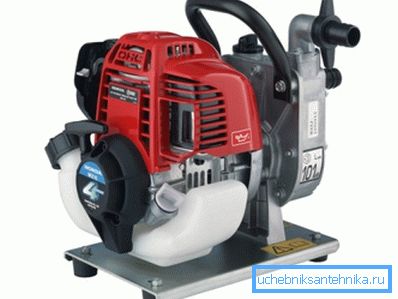Manual pump for a well: device, versions, scope
A downhole pump does not have to be electric. How is the manual pump pump for the well? Does it have any limitations associated with the device? How and where is this fixture mounted?
Let's figure it out.

Why do you need it
But in fact, why do we need hand pumps? At the very least in the courtyard of the twenty-first century. Is it time to completely switch to electrical equipment?
Alas. The future has come very selectively. If in large cities we are met by electric cars and free wireless Internet, then in the Russian outback very little has changed since the end of the 19th century: Ilyich light bulb in many places is still considered a luxury.
Countless garden partnerships are completely cut off from communications and power supply. Where there is nominally electricity, in practice there are frequent power outages: wire theft, falling trees and other vicissitudes of fate incline the site owner to maximum autonomy. The output in terms of water supply is obvious: the hand pump for the well is completely independent of any external power sources.
Let us specify: along with manual pumps for water supply, motor-driven pumps operating on gasoline or diesel fuel are used. They are significantly superior in performance handheld devices.
Device
What does a hand pump consist of?
The circuit is not complicated: many devices of this type are assembled with their own hands in artisanal conditions.

- The main elements of the device - the cylinder; piston with valve with one-way capacity for water; one more check valve at the bottom of the cylinder and a lever.
- When the lever is pressed, the piston rises, dragging the water standing in the cylinder. It is forced out through the gander into a substituted container or hose; The inlet valve is open at the same time, and water is sucked into the cylinder from the well.
- During the return stroke of the lever, the inlet valve closes. The piston goes down idle; since the rubber gland in this mode unbent, passing water, the movement of the lever does not meet significant resistance.
Restrictions
They are associated with the location of the hand pump above the water level.
- The suction pipe for the pump to work must be filled with water.. The instruction is related to the fact that water practically does not change its volume, but pumping air due to the inevitable fluctuations of its pressure can take several minutes, or even not at all successful.
Hint: The easiest way to ensure constant pipe filling is to install a check valve at its lowest point. Spring from it is better to remove. In this way, we avoid the loss of vacuum during the working stroke of the piston.
- The maximum distance from the pump to the water mirror does not exceed 7-8 meters. With a greater height difference, the vacuum created in the pipe will be insufficient to raise the water column.
A special case
Along with manual pumps, which are located above the water level, there are also mechanically submersible devices. How are they arranged?

The same construction is not located above the level of the casing, but immersed in it below the mirror of water. Above is mounted a lever connected to a rigid piston. The cylinder of the pump combines a pressurized pipe with a gander.
How much more effective is such a scheme? Since the efficiency of the pump no longer rests on the vacuum created in the pipe, the muscular effort developed by the pump owner remains the only limiting factor. The author was mentioned mentioning the rise of water with a manual pump of this type from a depth of 36 meters.
When designing a submersible pump with a stiff load, one technical problem arises.
The requirements for its design are mutually exclusive in some way:
- Traction must have a minimum mass. With a considerable length of its weight significantly increase the force on the lever.
- However, during the return stroke, too light a rod can be deformed.
The problem is solved simply and gracefully: a hollow draft of light alloy moves inside the tube, preventing its deformation.

And instead of the heart - a fiery motor
In which cases it is more profitable to use a pump with a gasoline or diesel engine?
- With a shallow depth of the well (the distance to the mirror should not exceed 7-8 meters). All motor-pumps are designed to be installed on the surface: oxidation of fossil fuels is impossible without atmospheric air.
- With the need for high performance with relatively rare inclusions. A typical scenario is a well with a large flow rate, which is used to fill a storage tank with a volume of several hundred liters.

- If necessary, raise the water to a greater height relative to the surface of the soil. The pressure at the exit is up to 70 meters of water.
It is clear that the price of the motor pump is several times higher than that of the manual counterpart; These devices are usually used during permanent residence in a country site.
What motor pump is needed for the well?
Let's separate the flies from the chops. The devices we discuss are often used not only in the operation of wells, but also in their drilling. Motor pumps for drilling wells have much greater productivity: they need to pump the maximum amount of water into the barrel to ensure the removal of sludge from the drilling area.
What with pumps for everyday use?
Actually, the minimum requirements.
- The performance of the device should not exceed the flow rate.
- Head - the minimum required. The more it is, the more fuel consumption.
- Self-priming devices that do not require pre-filling with water are preferred.

Conclusion
The video in this article, as usual, will offer you additional material. Successes!